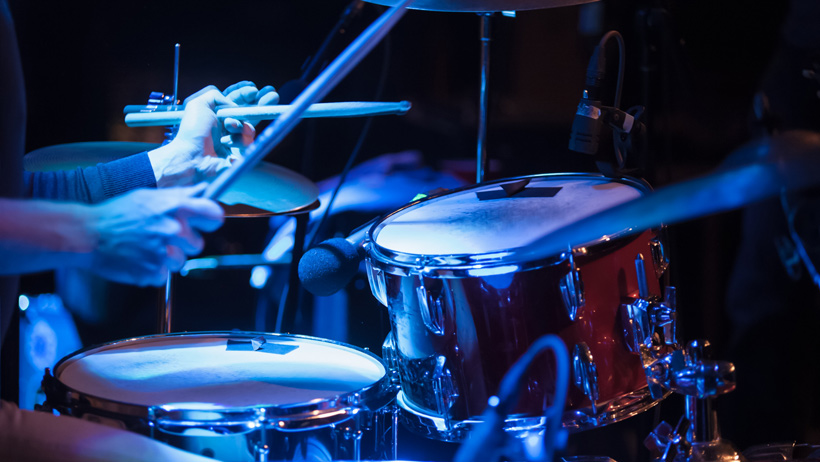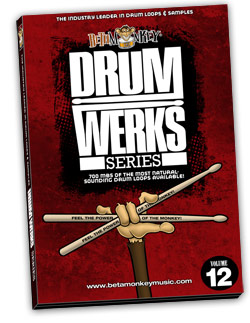A Closer Look at Blues Drum Loops and Blues Drumming Styles

To many folks, blues drumming is quickly lumped into one or two stereotypical rhythms: the 12/8 groove or the shuffle.And, it’s easy to understand how this could happen. Countless well-known blues songs do make use of these essential blues drum style rhythms.
But, if you really know and live the blues, you know that there are so many more variations of the shuffle and other traditional blues drumming styles. From a seemingly infinite variety of shuffle types often delineated by geographical origin to stylistically-unique variations on the 12/8 time signature, the world of blues drumming styles is as diverse as it is ubiquitous.
So, let’s explore what really encompasses blues drumming in general and then break out many of the different groove sub-genres that drummers have created over the years.
Be sure to download these blues drum loops that feature many of the grooves styles explored in this article as well.
Table of Contents
What do all blues drumming styles have?
A Deep Pocket
Playing deep in the pocket is a hallmark of all blues drumming. The definition of “pocket” can be debated but many agree it describes the drummer’s creation of a solid rhythmic foundation within the music so that other musicians can know exactly where the groove is.
Within a blues band context, for example, if the guitarist wants a rhythm that sits a little deeper, the drummer could drive the groove appropriately. Perhaps a simple push of the kick to land right on top of the beat will establish the foundation, but playing the snare with a somewhat lazier feel, just placed slightly behind on the “2 and 4” backbeat, will establish the type of pocket the music calls for.
Of course, “pocket” is often debated because it really cannot be expressed in in musical notation. It’s more of a feel that is established “between the notes” so to speak. And, by all accounts, playing in the pocket is not exclusively a blues thing. Latin, reggae, funk and other musical styles often require a laid-back pocket feel. It’s a feel that can be challenging to describe but undeniable to hear, feel, and sense.
Despite how challenging defining “pocket” may be, it all becomes clear when the band is locked in to that same rhythmic space and things start cooking. That pocket, which typically sits slightly behind the other band members, establishes the groove and allows any and all dynamic variations from it to propel the music.
Bottom line? A deep pocket is essential to tightly locking the band and music together. And, it goes without saying that all revered blues drummers have the deepest of pockets.
A Swinging Bounce
Whether you sense that “bounciness” of the groove on the hi-hat, ride, or snare, all great drummers add an indescribable bounce to their playing. And, you know it when you hear it, or more important, FEEL it. The bouncy quality is what moves to the audience to dance or, at the very least, tap their feet. It also inspire the music and band to add that same light bounce to their playing as well. This bluesy bounce can be expressed in even a simple “four on the floor” bass drum pattern. No matter how it’s played, drummers know that a bouncy swing is primarily to this genre of music.
Diverse Variations
First, blues drumbeats cover a lot of ground in terms of time signatures. You’ll hear the blues played in 2/4, 4/4, 6/8 and 12/8 time with distinct bar patterns. And, within these different time signatures, you hear many variations of triplet based rhythms, including localized shuffle styles (Texas, Chicago, Charleston, and so on). Ultimately, what matters most is that there’s a blues rhythm ideal for wherever blues artists want to take their blues. Slow and wailing? Upbeat and jumping? No matter, there’s a groove perfect for that.

Related: Drum Werks XII: 12/8 blues, shuffles, blues-rock
What are some well-known (and perhaps not so well-known) blues drumming styles and sub-genres?
Of course, the go-to beats of the blues are 12/8 and shuffles. And, you could just live on those alone. But, the blues exists in other time signatures as well, namely 2/4 (double-time), 4/4, and 6/8. In terms of variations, you have many diverse feels and flavors of blues
Delta Traditional Slow Blues
The earliest known form of the blues. With guitar and harmonica as the dominant instruments, this style of the blues takes its name from the region of the United States where it originated: the lower Mississippi Delta region. The early Delta Blues styles is a style recognizable to all blues fans and formed the foundation that many, if not all, of the other blues styles were built upon.
Interestingly enough, the earliest recordings of the Delta blues proved an inspiration to a young generation of British musicians who took what they were hearing from the American blues artists and created skiffle music. Of course, British skiffle led to the bluesy influence found in many of the British invasion bands. In another development, the early Delta blues records inspired British blues as well as early hard rock and even heavy metal (listen to early Sabbath and it’s tough to deny the role the early blues music had on these four lads from Birmingham.
Example Track: Elmore James, “Dust My Broom”
Elmore James’s version “Dust My Broom”, the Robert Johnson’s classic. While in many ways more aggressive than the original, the Delta origins are firmly in place throughout this recording of the track.
![]()
Looking to get some traditional blues grooves into your own music? Check out: Traditional 12/8 blues and shuffle drum loops – you get it all on Drum Werks XXIII.
Blues-Rock Drumming
Anyone who claims to be a rock drummer owes much of what they play to blues drummers. But, how does the acoustic stylings of the earliest blues players eventually come to influence rock, hard rock, and even early heavy metal music? Some would point to the migration of the Mississippi Delta blues musicians up to the cities of the north, notably Chicago. These city bars were louder and certainly more raucous than the country venues these early artists were accustomed to playing.
So, how did they adapt? By turning up the volume, of course!
Muddy Waters, in particular, began amplifying his guitar to cut through the crowd noise and, as such, others followed. Legendary Chicago blues drummers like Leroy Foster, Frederick Below, Jr., Sam Lay and others began to adapt to the louder environments. The drums began to develop into a heavier, thicker sound, delivering more of a solid pulse than the lighter, almost jazz-like brushwork drummers had been playing prior to amplification.
Example Track: Baby Face Leroy Trio, “Rollin’ And Tumblin”
Listening to some of the earliest recording of the Chicago blues, one could easily hear a direct lineage to the approach John Bonham took to the drums on the first Led Zeppelin album.
Looking to get some heard-hitting bluesy-rock, blues-rock grooves into your own music? With 12/8 grooves, shuffles, boogies and other blues styles, Drum Werks XII: 12/8 blues, shuffles, blues-rock serves up a wealth of authentic drum tracks for you to create your own tracks.
Funk Blues
Essentially, funk developed as a the natural byproduct of jazz, soul, and blues drumming. With artists like James Brown leading the way, this unique combination of styles and attitudes exploded with grooves that had blues roots but were more syncopated and complex if not always faster. In essence, the early blues drumming influence became secondary to grooves that were more danceable and predictably ‘groovy.’
Example Tracks: Funky Blues 1960’s-1970’s: A compilation of incredibly diverse tunes united by one thing: mixing that blues swing and feel with the inventiveness and motion of funk
Namesake Styles
On top of those, there are many namesake styles (named after the primary innovator and purveyor of the particular grooves):
Bo Diddley: Not a traditional bluesy feel by any means, but one that had a loose, bluesy boogie feel to it. What it lacked in formal structure, however, was easily forgotten about when the infectious boogie feel took over. This groove became so well-known that it even got its own name: the “Bo Diddley Beat”!
Buddy Guy: When it came to blues shuffles, Buddy Guy and his backing band at the time could serve it up and then some! The signature Chicago Blues shuffle was always in full effect behind the man and his guitar.
B.B. King: Though capable of many feels and moods, many know the blues stylings of B.B. King from his more well-known tunes. Smooth yet dynamic, laid-back and with a deep pocket, the drums created so much space for the guitarist to wail, sing, and speak. With so many worthy cuts, it’s difficult to nail it down to just one so we’ll go with the tune everyone knows (“The Thrill is Gone”) but maybe in a format you may not have heard: the isolated drums themselves. Talk about a serious pocket!
Chuck Berry: The 50s rolled around but the blues persisted, only to take on a new life in the birth of Rock n’ Roll. But, even in these different times, you still have to have that deep pocket and bounce if it’s going to cut it for the audience. Even with the tempo and instruments dialed up, the swing, shuffle, and feel of the blues carried. A new generation thought they were hearing something entirely new and, in some ways, they were. But, the roots were and remain undeniably in the blues.
Shuffle Styles
As for shuffles, there are many different variations:
- Chicago blues shuffle
- Texas shuffle
- Charleston shuffle
- Swing Shuffle
- Jazzy Swing Shuffle
- Box Car shuffle
If there is one rule to follow when it comes to the blues and the type of drum styles that works best, just remember that the rhythm that supports the music best is best. If it feels right, then it probably is.
So, what’s the bottom line?
If you’ve been searching for the essential blues grooves and rhythms, Beta Monkey has the blues drum loops you need. While we probably haven’t covered every blues drumming style covered in this article, we have done our best to try. And, based on the wide and rich landscape of blues rhythms, you’d have to agree that would be quite a feat!
